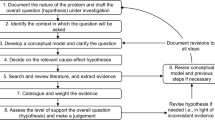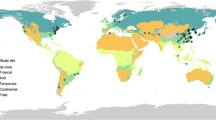Abstract
Three vegetation-based indicator systems for the assessment of the trophic state of soil were tested on grasslands. External parameters were gross production and nitrogen supply. A high correlation was found between indication figures of the relevés and external parameters. There was some evidence that, under certain conditions, indicator systems could provide ordinal as well as cardinal information. The reliability of the indicator systems was not entirely dependent on the completeness of the vegetational information. The lack of abundance data and the ignoring of rarely occurring species did not seriously affect the strength of correlation. It was concluded that indicator systems can be useful tools in ecological research as well as in nature conservation policy.
Similar content being viewed by others
References
Allen, S. E., Grimshaw, H. M., Parkinson, J. A. & Quarmby, C. 1974. Chemical analysis of ecological materials. Blackwell, Oxford.
Best, E. P. H. & Haeck, J. 1984 (eds). Ecologische indicatoren voor de kwaliteitsbeoordeling van lucht, water, bodem en ecosystemen. Pudoc, Wageningen.
Böcker, R., Kowarik, I. & Bornkamm, R. 1983. Untersuchungen zur Anwendung der Zeigerwerte nach Ellenberg. Verh. Ges. Ökol. 11: 35–56.
Boeker, P. 1954. Bodenreaktion, Nährstoffversorgung und Erträge von Grünlandgesellschaften des Rheinlandes. Z. Pfl. Ernähr. Düng. Bodenkde 66: 54–64.
Bornkamm, R. & Hennig, U. 1982. Experimentell-ökologische Untersuchungen zur Sukzession von ruderalen Pflanzengesell-schaften auf unterschiedlichen Böden. Flora 172: 267–316.
Bosch, S., Oostendorp, D. & Harmsen, H.E. 1963. Stikstofbemesting en gebruikswijze van grasland. PAW Meded. 88, Wageningen.
Brown, G. H. 1979. An optimalization criterion for linear inverse estimation. Technometrics 21: 575–579.
Clausman, P. H. M. A., den Held, A. J., Jalink, L. M. & Runhaar, J. 1987. Milieu-indicatie van vegetaties. Het vegetatieonderzoek van de provincie Zuid-Holland. Deelrapport II. Province of South Holland, The Hague.
deBoer, Th. A. & deGooijer, H. H. 1979. Kartering van korte vegetaties van het kultuurlandschap. Karteringsverslag 185. CABO, Wageningen.
de Vries, D. M. 1937. Methods of determining the botanical composition of hay fields and pastures. Rep. 4th Intern. Grassl. Congr., Aberystwyth: 474–480.
Durwen, K. J. 1982. Zur Nutzung van Zeigerwerten und artspezifischen Merkmalen der Gefässpflanzen Mitteleuropas für Zwecke der Landschaftsökologie und-planung mit Hilfe der EDV-Voraussetzungen, Instrumentarien, Methoden und Möglichkeiten. Arbeitsber. Lehrst. Landschaftsökol. Münster 5: 1–138.
Elberse, W. Th. 1966. Invloed van gebruik en bemesting op botanische samenstelling en produktie van verwaarloosd grasland (Verslag proefveld ALG/IBS 72, 1957–1962) IBS Verslag 40, Wageningen.
Elberse, W. Th., van derBerg, J. & Dirven, J. P. G. 1983. Effects of use and mineral supply on the botanical composition of old grassland on heavy river-clay soil. Neth. J. Agric. Sci. 31: 63–88.
Ellenberg, H. 1958. Bodenreaktion (einschliesslich Kalkfrage). In: Ruhland, W. (ed.), Encyclopedia of plant physiology; IV. Mineral nutrition of plants, pp. 638–708. Springer, Berlin.
Ellenberg, H. 1979. Zeigerwerte der Gefässpflanzen Mitteleuropas. Scripta Geobot. 9, Göttingen.
Ennik, G. C. 1965. The influence of management and nitrogen application on the botanical composition of grassland. Neth. J. Agric. Sci. 13: 222–237.
Floate, M. J. S. 1970. Mineralization of nitrogen and phosphorus from organic materials of plant and animal origin and its significance in the nutrient cycle in grazed uplands and hill soils. J. Br. Grassl. Soc. 25: 295–302.
Harrison, A. F. 1978. Phosphorus cycles of forest and upland grassland ecosystems and some effects of land management practices. In: Potter, R. & Fitzsimon, D. W. (eds), Phosphorus in the environment: its chemistry and biochemistry. pp 175–199. Elsevier, Amsterdam.
Hill, M. O. 1973. Reciprocal averaging: an eigenvector method of ordination. J. Ecol. 61: 237–249.
Kruijne, A. A., deVries, D. M. & Mooi, H. 1967. Bijdrage tot de oecologie van de Nederlandse graslandplanten. Agric. Research Reports 696, Pudoc, Wageningen.
Lantinga, E. A., Keuning, J. A., Groenwold, J. & Deenen, P. J. A. G. 1987. Distribution of excreted nitrogen by grazing cattle and its effects on sward quality, herbage production and utilization. In: van derMeer, H. G. et al. (eds), Animal manure on grassland and fodder crops. pp. 104–117. Nijhoff, Dordrecht.
Loopstra, I. L. & van derMaarel, E. 1984. Toetsing van de ecologische soortengroepen in de Nederlandse flora aan het systeem van indicatiewaarden volgens Ellenberg. Rapport 381, Dorschkamp, Wageningen.
Melman, Th. C. P., Udo de Haes, H. A. & vanStrien, A. J. 1986. Slootkanten: aanknopingspunt voor natuurbehoud in het veenweidegebied? Landschap 3: 190–202.
Persson, S. 1981. Ecological indicator values as an aid in the interpretation of ordination diagrams. J. Ecol. 69: 71–84.
Runhaar, J., Groen, C. L. G., van derMeijden, R. & Stevers, R. A. M. 1987. Een nieuwe indeling in ecologische groepen binnen de Nederlandse flora. Gorteria 13: 277–359.
terBraak, C. J. F. & Gremmen, N. J. M. 1986. Ecological amplitudes of plant species and the internal consistency of Ellenberg's indicator values for moisture. Vegetatio 69: 79–87.
Tüxen, R. 1979. Soziologische Veränderungen in zwei Dauerquadraten einer Weser-Wiese bei Stolzenau (Krs. Nienburg) von 1945–1978. In: Tüxen, R. (ed.), Gesellschaftsentwicklung (Syndynamik) pp. 339–359. Cramer, Vaduz.
van derMaarel, E. 1979. Transformation of cover-abundance values in phytosociology and its effects on community similarity. Vegetatio 39: 87–114.
vanSteenbergen, T. 1976a. Het effekt van stikstofbemesting op de gewasopbrengst van grasland bij diverse ontwateringstoestanden en grondsoorten. Deel II (1964–1973). CABO, Wageningen.
vanSteenbergen, T. 1976b. De invloed van de weersgesteldheid en de stikstofbemesting op de jaaropbrengst van grasland. CABO, Wageningen.
vanSteenbergen, T. 1977. Invloed van grondsoort en jaar op het effekt van stikstofbemesting op de graslandopbrengst. Stikstof 85: 9–15.
vanStrien, A. J. & Melman, Th. C. P. 1987. Effects of drainage on the botanical richness of peat grassland. Neth. J. Agric. Sci. 35: 103–111.
Author information
Authors and Affiliations
Rights and permissions
About this article
Cite this article
Melman, T.C.P., Clausman, P.H.M.A. & Udo de Haes, H.A. The testing of three indicator systems for trophic state in grasslands. Vegetatio 75, 143–152 (1988). https://doi.org/10.1007/BF00045627
Accepted:
Issue Date:
DOI: https://doi.org/10.1007/BF00045627




